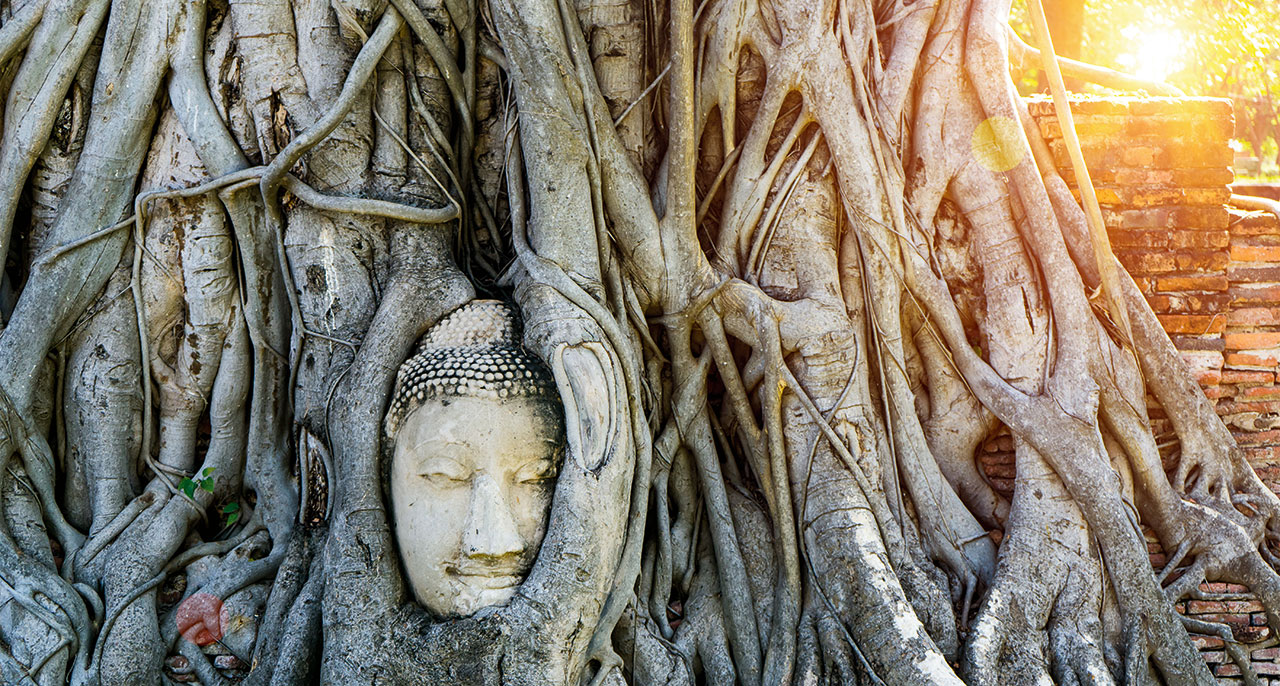When I was young, trees were my friends. I’d climb up among the branches of the ones beside our three-story apartment building until I was higher than the roof. Perched among clouds and birds, I found comfort and ease. The friendliest tree was the sycamore. It had such smooth skin beneath my fingers.
A few years ago, I discovered a past-life (Jataka) tale in which the Buddha himself was the consciousness of a tree. Childhood memories awoke. I remembered my old friends.
Perhaps trees are bodhisattvas. After all, the Buddha was born under trees, realized enlightenment under a tree, and died beneath trees.
Buddhist tradition holds that the Buddha told a number of past-life tales to teach about karma, reveal the unity of all life, and demonstrate the bodhisattva’s path of wisely maturing beyond habitual self-centeredness to compassionately benefit all.
In a Jataka tale the Buddha can appear as an animal, a human, or as a supernatural being. Many of these 2,500-year-old tales speak to issues we know well: greed, anger, selfishness, hatred, environmental destruction, and complex ethical choices. In them an animal—or even a tree—can be more spiritually mature than a human.
Do trees aspire to goodness? Can they save others? The three general resolutions of Buddhism are “avoid evil, do good, and save the many beings.” Can a tree do this without eyes, ears, nose, tongue, hands, or feet? If it can, perhaps we should reconsider the nature of our world.
In Ganatindu Jataka, no. 520 in the Pali Jataka, a collection of 547 past-life tales, the Buddha, as the divinity or consciousness of a tree, saves a kingdom. Let me tell you the story.
Once there was a king whose luxurious lifestyle threatened his kingdom. Despite his excesses, each year, following ancient custom, he made offerings to a tree known for its healing power, asking for the tree’s protection.
The Buddha, as the consciousness of that tree, thought: “This king’s selfishness threatens the realm. I must save him and his kingdom. I alone can do it.”
That night the tree bodhisattva appeared like a burning bush in the king’s bedchamber and said, “Great king, due to your selfish ways, your kingdom will fall into ruin. Go among your people and learn the truth.”
Shaken, the king donned ordinary clothes and left the capital city. Eventually, he came across a man whose forest home was fenced by thorny branches. When the man pierced his foot on the thorns, he blamed the king. Previously, the man had lived in the city, but he’d had to flee to the forest because of thieves and tax collectors, that is, because of the king’s mismanagement of the city. In pain, he cursed the king: “May he be pierced in some fray as I’ve been pierced today.”
Hearing this, the king wanted to turn back and set things right. But the tree bodhisattva inspired the king to continue on.
Next, they saw a woman fall under a load of firewood. Without money, she couldn’t provide the dowry for her daughters, and without husbands, her daughters weren’t safe gathering firewood in the forest, so the woman had to do it herself. Blaming the king for her poverty, she cursed him.
The king then went on to encounter a plowman, a dairyman, a cow grieving the loss of her calf, and a frog being eaten by a crow. Each, in turn, blamed the king for their misery and cursed him, and the king—having learned his lesson—finally returned home. From then on, he ruled wisely and the kingdom prospered.
The repetition in this tale shows that the bodhisattva means business. He’s not just giving a warning. The state rots from the top down, and he means for the king to see the consequences of his thoughtlessness, even for the smallest creature. Except for an initial visitation, the bodhisattva never reveals himself. The only sign of his presence is when characters launch into invectives against the king; it’s the bodhisattva who inspires their poetic curses.
The bodhisattva’s encouragement extends beyond his own tree, spreading throughout the land. Is that impossible? Trees are mobile to a limited extent. Roots avoid obstacles and seek water, leaves turn toward light, and chemical messages spread along fungal networks, though slowly compared to the nervy quickness of animals.
Contemporary research suggests that forests may form a worldwide-wood-web of compassionate intercommunication. Trees have families. Older trees guide nutrients to younger kin, younger ones do the same for aging tree relatives. In fact, trees shelter so many lives, who’s to say they’re not compassionate? Squirrels, bugs, birds, snakes, fungi, insects, and grubs find homes in them. We shelter beneath their branches, gather fruit, nuts, bark, and sap for medicine and food. Then in death, trees add nutrients to the soil; we build houses from their bones.
Over hundreds of millions of years, plants and trees formed soil and transformed our barren rock into a garden. Now they oxygenate our atmosphere and pull heavy metals from the earth, pollutants from the air. They do not kill to live; they photosynthesize energy directly from sunlight. How’s that for nonharming? Who’s to say that no compassionate aspiration lies beneath this?
Perhaps trees are bodhisattvas. After all, the Buddha was born under trees, realized enlightenment under a tree, and died beneath trees. When I think of the word “buddha,” I’m reminded of the verb “to bud.”
In addition to trees being woven into the living fabric of forests and cities via roots, leaves, and fungal webs, trees also extend upward beyond the planet to the sun, moon, and stars; like all life on earth, they’re mostly made of stardust. So, it’s fitting that in a Jataka tale the bodhisattva consciousness of a tree uses the vast, living network in which it’s embedded, to create a context through which wisdom and compassion can arise.
The way the tree bodhisattva skillfully creates space for the possibility of insight and understanding is a model for what real teaching comes down to. Wisdom and compassion can’t be given to anyone, but they can be shown, enabling ordinary folks and kings alike to move to more beneficial ways of living.
I remember that sycamore of my childhood, and how I’d feel the warmth of its bole and limbs in summer. The tree’s steady, creaking sway was like a heartbeat.

